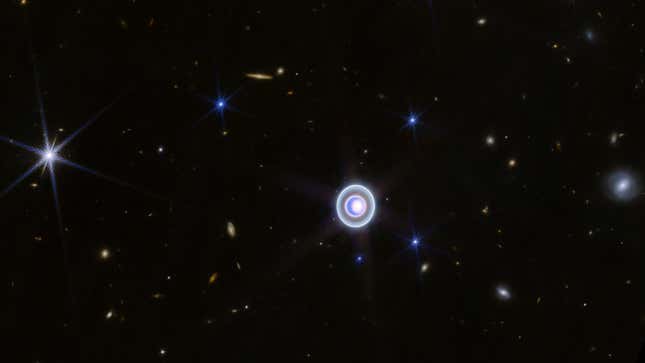Yes, that’s Uranus. The giant icy orb looks more like an agatized dinosaur egg than a planet in this new image by the Webb Space Telescope.
Uranus, the seventh planet from the Sun, still holds plenty of secrets. We know it’s an ice giant, thought to be mostly (80% or more) icy water, ammonia, and methane surrounding a rocky core, and that it has skies rich with hydrogen sulfide. It also has a ring system, one that’s far less familiar to us than the circles around Saturn.
Advertisement
Though Uranus’ rings were imaged before—by Hubble in November 2014 and November 2022 and by Webb in April, the new, gorgeous image adds some detail. For one, this Webb image—taken by the observatory’s Near-Infrared Camera (NIRCam)—captures the planet’s faint Zeta ring, the ring closest to the planet.
Advertisement
The close-up above shows nine of the planet’s moons. In clockwise order, starting at 2 o’ clock, they are Rosalind, Puck, Belinda, Desdemona, Cressida, Bianca, Portia, Juliet, and Perdita. Uranus’ moons are sometimes called the “literary moons,” NASA’s website states, because they are named for characters in the works of William Shakespeare and Alexander Pope.
Advertisement
Uranus has 27 known moons, 14 of which are visible in the image below: Oberon, Titania, Umbriel, Juliet, Perdita, Rosalind, Puck, Belinda, Desdemona, Cressida, Ariel, Miranda, Bianca, and Portia, according to an ESA release.

Advertisement
The deep blue crescent on Uranus is caused by the large north polar cap, which dominates the planet’s right side from Webb’s perspective. Uranus has an extreme tilt relative to the solar system’s orbital plane, which is why its northern pole is oriented toward the Sun. The polar cap will be facing Earth directly in 2028, giving Webb and Hubble scientists an opportunity to better image the unique structure.
Uranus is way more than the butt of our jokes; it is a venue of intrigue for planetary scientists. In October, analysis of data from the Keck II telescope revealed a reddish color rimming the planet, an aurora caused by the ion H3+, which glows in the infrared in Uranus’ skies.
Advertisement
Last year, the National Academies of Sciences, Engineering, and Medicine named Uranus as one of the top priorities for science in the next decade. Specifically, the academies’ report says that the highest priority flagship mission through 2032 should be a probe of Uranus. Yes, the jokes write themselves, but that doesn’t make the study of this planet any less important.
More: The Best Space Images of 2023
Services Marketplace – Listings, Bookings & Reviews